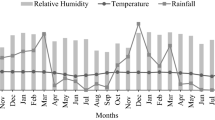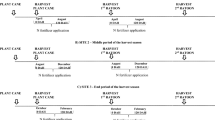Abstract
A field experiment conducted at the Indian Agricultural Research Institute, New Delhi during the years 1976–79 involving two planted cane crops and two ratoons showed that nitrogen application to planted cane increased the millable cane and sugar yields of the planted cane and had a significant residual effect on the ratoon. Taking together the yields of planted cane and ratoon, an application of 150 kg N ha−1 increased the yield of millable cane by 33.3t ha−1 and that of sugar by 3.9t ha−1. The results suggested that with 75 kg N ha−1 three-quarters should be applied at planting, while with 150 kg N ha−1 only half should be applied at planting. The remaining dose of nitrogen should be applied at earthing up. Foliar application of part of the nitrogen indicated some advantage in the case of millable canes in the planted cane, but this did not show up in the sugar yield.
Similar content being viewed by others
References
Bhoj RL, Singh PK and Kirtikar (1964) Appropriate time of application of ammonium sulphate to sugarcane crop. Proc 5th All India Conf Sugarcane Res & Dev Workers, pp 172–176
De R (1971) A review of foliar fertilization of crops in India. Fertil News 16(12), 77–82
Mathur RBL (1978) Handbook of cane sugar technology. New Delhi: Oxford and IBH
Parashar KS, Saraf CS and Sharma RP (1978) Studies on the effect of soil moisture regimes and fertilizer levels on spring planted sugarcane grown pure and intercropped withmoong. Indian Sugar 28, 1–9
Ray S (1963) Study of moisture losses under cropped conditions and on base soil and some measures for the efficient utilization of moisture for crop production (principal crops sugarcane & potatoes). Ph.D. thesis, I.A.R.I., New Delhi
Samuel G (1956) The efficiency of sugarcane in its use of nitrogen fertilizer application. J Agric Univ Puerto Rico 40(4), 209–217
Singh S and Kanwar RS (1964) Studies on the yield behaviour of some cane varieties in the Punjab under optimum and restricted water supply. Indian Sugar 13, 621–623
Spencer GL and Meade GP (1945) Cane sugar handbook, 9th edn, pp 619–627 and 681–683. New York: John Wiley
Srivastava SC (1969) On the rationale of the time of nitrogen fertilization for sugarcane. Proc Int Soc Sugarcane Technol 13, 151–160
Author information
Authors and Affiliations
Rights and permissions
About this article
Cite this article
Parashar, K.S., Prasad, R., Singh, S. et al. Effect of level, timing and method of nitrogen application on spring-planted sugarcane. Fertilizer Research 2, 127–134 (1981). https://doi.org/10.1007/BF01080099
Issue Date:
DOI: https://doi.org/10.1007/BF01080099




